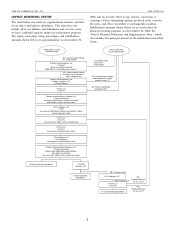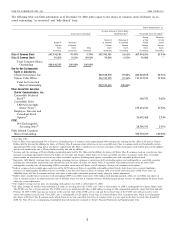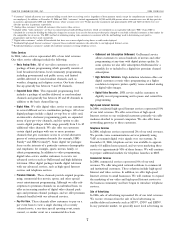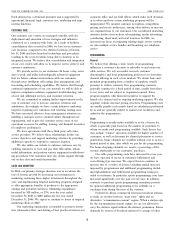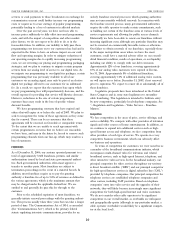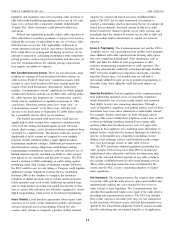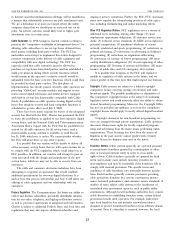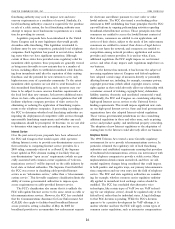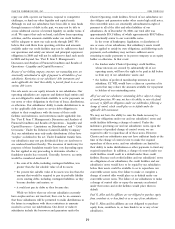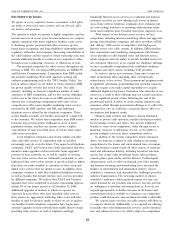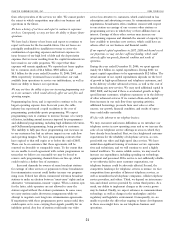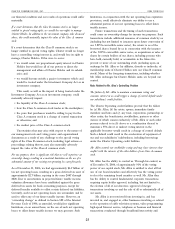Charter 2006 Annual Report Download - page 27
Download and view the complete annual report
Please find page 27 of the 2006 Charter annual report below. You can navigate through the pages in the report by either clicking on the pages listed below, or by using the keyword search tool below to find specific information within the annual report.
CHARTER COMMUNICATIONS, INC. 2006 FORM 10-K
facilities already in place that are capable of delivering cable REGULATION AND LEGISLATION
television programming. The following summary addresses the key regulatory and
As of December 31, 2006, we are aware of traditional legislative developments affecting the cable industry and our
overbuild situations impacting approximately 7% of our total three primary services: video service, high-speed Internet service,
homes passed and potential traditional overbuild situations in and telephone service. Cable system operations are extensively
areas servicing approximately an additional 4% of our total regulated by the FCC, certain state governments, and most local
homes passed. Additional overbuild situations may occur. governments. A failure to comply with these regulations could
Private Cable subject us to substantial penalties. Our business can be dramati-
Additional competition is posed by satellite master antenna cally impacted by changes to the existing regulatory framework,
television systems, or SMATV systems, serving multiple dwelling whether triggered by legislative, administrative, or judicial
units, or MDUs, such as condominiums, apartment complexes, rulings. Congress and the FCC have expressed a particular
and private residential communities. These private cable systems interest in increasing competition in the communications field
may enter into exclusive agreements with such MDUs, which generally and in the cable television field specifically. The 1996
may preclude operators of franchise systems from serving Telecom Act altered the regulatory structure governing the
residents of such private complexes. Private cable systems can nation’s communications providers. It removed barriers to
offer improved reception of local television stations, and many competition in both the cable television market and the local
of the same satellite-delivered program services that are offered telephone market. At the same time, the FCC has pursued
by cable systems. SMATV systems currently benefit from spectrum licensing options designed to increase competition to
operating advantages not available to franchised cable systems, the cable industry by wireless multichannel video programming
including fewer regulatory burdens and no requirement to distributors. We could be materially disadvantaged in the future
service low density or economically depressed communities. if we are subject to new regulations that do not equally impact
Exemption from regulation may provide a competitive advan- our key competitors.
tage to certain of our current and potential competitors. Congress and the FCC have frequently revisited the subject
of communications regulation, and they are likely to do so in
Wireless Distribution the future. In addition, franchise agreements with local govern-
Cable systems also compete with wireless program distribution ments must be periodically renewed, and new operating terms
services such as multi-channel multipoint distribution systems or may be imposed. Future legislative, regulatory, or judicial
‘‘wireless cable,’’ known as MMDS, which uses low-power changes could adversely affect our operations. We can provide
microwave frequencies to transmit television programming no assurance that the already extensive regulation of our
over-the-air to paying customers. MMDS services, however, business will not be expanded in the future.
require unobstructed ‘‘line of sight’’ transmission paths, and
MMDS ventures have been quite limited to date. VIDEO SERVICE
The FCC has completed its auction of Multichannel Video
Cable Rate Regulation. The cable industry has operated under a
Distribution & Data Service (‘‘MVDDS’’) licenses. MVDDS is a
federal rate regulation regime for more than a decade. The
new terrestrial video and data fixed wireless service that the
regulations currently restrict the prices that cable systems charge
FCC hopes will spur competition in the cable and DBS
for the minimum level of video programming service, referred to
industries.
as ‘‘basic service,’’ and associated equipment. All other cable
Other Competitors offerings are now universally exempt from rate regulation.
Local wireless Internet services have recently begun to operate Although basic rate regulation operates pursuant to a federal
in many markets using available unlicensed radio spectrum. formula, local governments, commonly referred to as local
Some cellular phone service operators are also marketing PC franchising authorities, are primarily responsible for administer-
cards offering wireless broadband access to their cellular ing this regulation. The majority of our local franchising
networks. These service options offer another alternative to authorities have never been certified to regulate basic cable rates
cable-based Internet access. (and order rate reductions and refunds), but they retain the right
High-speed Internet access facilitates the streaming of video to do so, except in those specific communities facing ‘‘effective
into homes and businesses. As the quality and availability of competition,’’ as defined under federal law. With increased DBS
video streaming over the Internet improves, video streaming competition, our systems are increasingly likely to satisfy the
likely will compete with the traditional delivery of video effective competition standard. We have already secured FCC
programming services over cable systems. It is possible that recognition of effective competition, and become rate deregu-
programming suppliers will consider bypassing cable operators lated in many of our communities.
and market their services directly to the consumer through There have been frequent calls to impose expanded rate
video streaming over the Internet. regulation on the cable industry. Confronted with rapidly
increasing cable programming costs, it is possible that Congress
may adopt new constraints on the retail pricing or packaging of
cable programming. For example, there has been considerable
13


